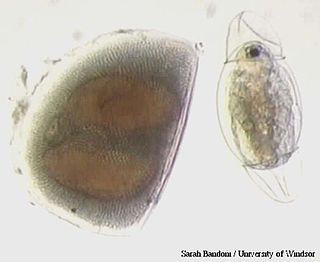
The Australian hornet is not a true hornet, it is a type of potter wasp or "mason wasp", is a vespid native to the Australian states and territories of the Australian Capital Territory, New South Wales, Northern Territory, Victoria, Queensland and Western Australia.

The saddleback toads (Brachycephalus) are a genus of tiny toads and frogs in the family Brachycephalidae in the order Anura, ranging from south Bahia to Santa Catarina in southeastern Brazil. The genus includes two main groups, the often brightly coloured pumpkin toadlets, and the overall brown and more frog-like flea frogs, which once were placed in their own genus Psyllophryne. Some pumpkin toadlets are toxic and their often bright colours are considered aposematic. At about 1 cm (0.4 in) or less in snout–to–vent length, the flea frogs are some of the smallest frogs in the world.

The painted moki, also known as the painted morwong, is a species of marine ray-finned fish, traditionally regarded as belonging to the family Cheilodactylidae, the members of which are commonly known as morwongs. It is found in the southwestern Pacific Ocean.

The pumpkin toadlet, or Spix's saddleback toad, is a small and brightly coloured species of frog in the family Brachycephalidae. This diurnal species is endemic to southeastern Brazil where it is found among leaf litter on the floor of Atlantic rainforests at an altitude of 200–1,250 m (660–4,100 ft). It is found in Espírito Santo, Rio de Janeiro, southeastern São Paulo and southeastern Minas Gerais. Although its type specimen supposedly was collected in Bahia about 200 years ago, there are no confirmed localities in this state and recent reviews consider it more likely that it was from Rio de Janeiro. B. ephippium is locally common, quite widespread compared to most other species of Brachycephalus and it is not considered threatened.

Brachycephalus nodoterga, also known as the Serra Cantareira saddleback toad, is a species of frog in the family Brachycephalidae. It is endemic to the eastern São Paulo state of southeastern Brazil, and only known from five locations in Atlantic rainforest at altitudes of 700–900 m (2,300–3,000 ft).

Anomiidae is a family of saltwater clams, marine bivalve molluscs related to scallops and oysters, and known as anomiids. It contains seven genera.

Placunidae, also known as windowpane oysters, windowpane shells, and Capiz shells, are a taxonomic family of saltwater clams, marine bivalve mollusks which are related to oysters and scallops.

The saddle butterflyfish is a species of marine ray-finned fish, a butterflyfish belonging to the family Chaetodontidae. It is found in the Indian and Pacific Oceans from Sri Lanka and the Cocos-Keeling Islands to the Hawaiian, Marquesan and Tuamotu islands, north to southern Japan, south to Rowley Shoals and New South Wales in Australia.

Laphria is a genus described by Johann Wilhelm Meigen in 1803, belonging to the family Asilidae, subfamily Laphriinae. Members of this genus are known as bee-like robber flies. This genus has a Holarctic distribution, occurring in Europe, Asia, and North America. They prey on a variety of insects, including other robber flies, bees, wasps and beetles. Like other asilids, they use their proboscis to penetrate the body of their prey and inject enzymes which dissolve the tissues.

Clitellaria ephippium is a species of soldier fly belonging to the family Stratiomyidae.

Ephippia are winter or dry-season eggs of the various species of small crustacean in the order Cladocera ; they are provided with an extra shell layer, which preserves and protects the resting stages inside from harsh environmental conditions until the more favorable times, such as spring, when the reproductive cycle is able to take place once again. Ephippia are part of the back of a mother carrying them until they are fully developed. After molting, the ephippium stays in the water, or in the soil of dried puddles, small ponds, and vernal pools. The resting stages are often called eggs, but are in fact embryos with arrested development. Ephippia can rest for many years before the embryo resumes development upon an appropriate hatching stimulus.

Brachycephalus pitanga, the red pumpkin toadlet, is a small and brightly coloured species of anuran in the family Brachycephalidae. It is endemic to Atlantic rainforests in São Paulo state of southeastern Brazil, and only known from four localities at an altitude of 900–1,140 m (2,950–3,740 ft) in Ubatuba and São Luiz do Paraitinga. It can be very common where found, and two of the known localities are protected by the Serra do Mar State Park. Unlike many other pumpkin toadlets, the red pumpkin toadlet is not considered threatened.

Neolema ovalis is a species of leaf beetle in the family Chrysomelidae. It is found in North America.

Eutomostethus ephippium is a species of common sawfly in the family Tenthredinidae.
Phylloicus is a genus of caddisflies in the family Calamoceratidae. There are more than 40 described species in Phylloicus.

Neolema dorsalis is a species of leaf beetle in the family Chrysomelidae. It is found in the Caribbean Sea, Central America, North America, and South America.
Anthicus ephippium is a species of antlike flower beetle in the family Anthicidae. It is found in Central America, North America, and Oceania.

Heza is a genus of assassin bugs in the family Reduviidae. There are more than 30 described species in Heza found in the Americas.
Neolema cordata is a species of leaf beetle in the family Chrysomelidae. It is found in North America.

Anomia ephippium is a species of bivalve belonging to the family Anomiidae.














